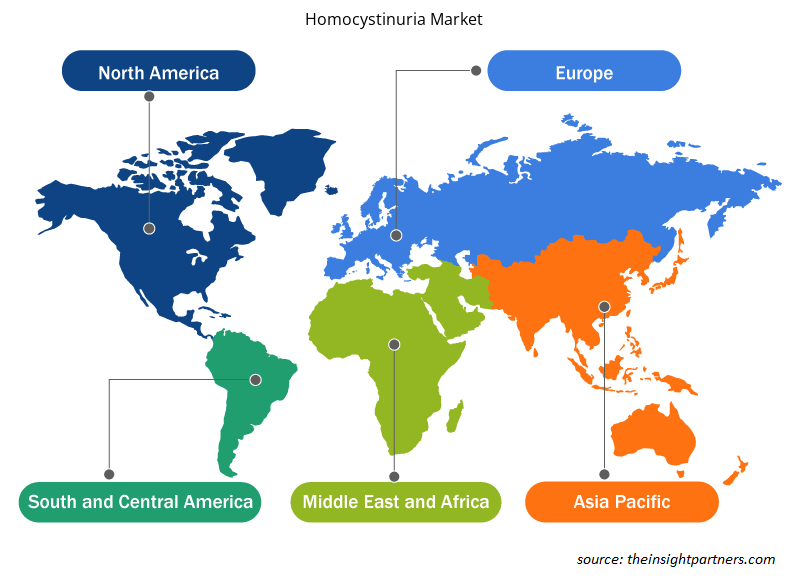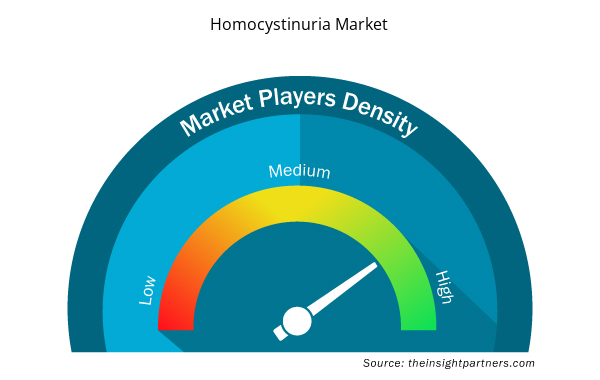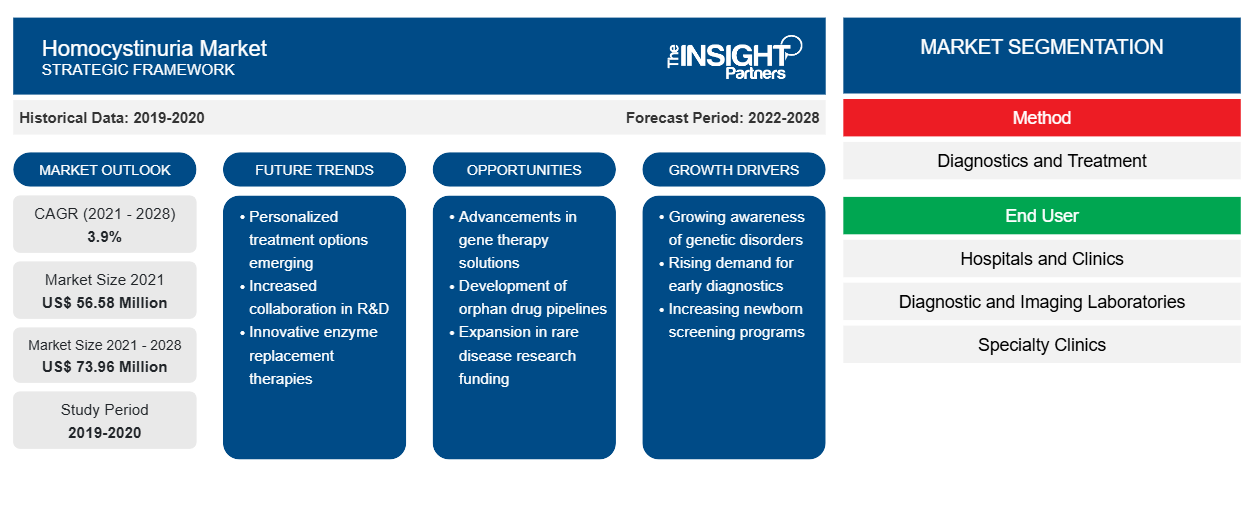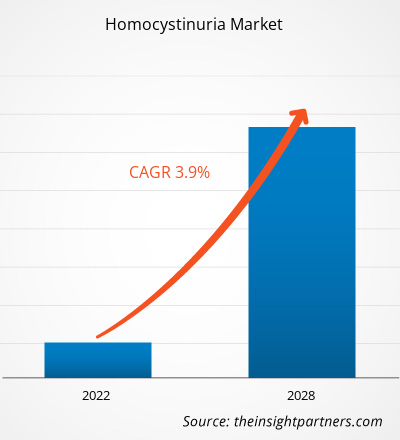预计到 2028 年,同型胱氨酸尿症市场规模将从 2021 年的 5658 万美元增至 7396 万美元;预计 2021-2028 年期间的复合年增长率为 3.9%。
同型胱氨酸尿症是一种遗传性疾病,患者身体无法正确消化某些蛋白质结构块(氨基酸)。同型胱氨酸尿症有多种类型,每种类型都有各自的体征和症状以及遗传病因。近视、眼前晶状体脱位、不规则血液凝结风险增加、骨质疏松易骨折(骨质疏松症)或其他骨骼异常是最常见的同型胱氨酸尿症类型。部分患者还会出现发育迟缓和学习困难。
定制此报告以满足您的需求
您可以免费定制任何报告,包括本报告的部分内容、国家级分析、Excel 数据包,以及为初创企业和大学提供优惠和折扣
- 获取此报告的关键市场趋势。这个免费样品将包括数据分析,从市场趋势到估计和预测。
同型胱氨酸尿症市场的增长归因于维生素 B6 和维生素 B12缺乏症的增加以及遗传性代谢疾病的患病率不断上升。然而,对各种罕见疾病和遗传性代谢疾病缺乏认识阻碍了市场的增长。
市场洞察
维生素 B6 和维生素 B12 缺乏症的增加推动了同型胱氨酸尿症市场的发展
维生素 B6 和维生素 B12 缺乏症的增加会导致贫血、巨幼细胞性贫血、小细胞性贫血和某些代谢紊乱等多种疾病,预计这将在预测期内推动市场增长。由于维生素 B6 疗法被认为是治疗高胱氨酸尿症的有效疗法,因此这种维生素的缺乏可能会使病情恶化。吡哆醇(维生素 B6)作为 β-合酶的辅助因子,并作为稳定几种错义突变的伴侣。一些高胱氨酸尿症患者对吡哆醇疗法反应良好,它有助于降低高半胱氨酸水平,从而缓解病情。因此,维生素 B6 被认为是治疗高胱氨酸尿症的关键,因为可用于治愈该病症的治疗方法数量有限。这种酶的缺乏会导致贫血和小细胞性贫血。贫血患病率的上升预计将在预测期内刺激市场增长。例如,根据世界卫生组织的数据,贫血影响了超过 16.2 亿人口,即 24.8% 的人口。贫血的主要原因是饮食不当和缺乏维生素 B6、B9 和 B12。维生素 B6 缺乏症是贫血的主要原因。因此,预计在预测期内,维生素 B6 缺乏症病例的增加和与其缺乏症相关的疾病的高患病率将支持市场增长。
基于方法的见解
根据治疗方法,全球同型胱氨酸尿症市场分为治疗和诊断两部分。2021 年,治疗部分占据了更大的市场份额。此外,由于目前治疗的使用情况以及对同型胱氨酸尿症新疗法的研究和开发不断增加,预计同一部分在预测期内的市场复合年增长率将更高。
同型胱氨酸尿症市场区域洞察
Insight Partners 的分析师已详尽解释了预测期内影响同型胱氨酸尿症市场的区域趋势和因素。本节还讨论了北美、欧洲、亚太地区、中东和非洲以及南美和中美洲的同型胱氨酸尿症市场细分和地理分布。

- 获取同型胱氨酸尿症市场的区域特定数据
同型胱氨酸尿症市场报告范围
| 报告属性 | 细节 |
|---|---|
| 2021 年市场规模 | 5,658万美元 |
| 2028 年市场规模 | 7,396万美元 |
| 全球复合年增长率(2021 - 2028) | 3.9% |
| 史料 | 2019-2020 |
| 预测期 | 2022-2028 |
| 涵盖的领域 | 按方法
|
| 覆盖地区和国家 | 北美
|
| 市场领导者和主要公司简介 |
|
同型胱氨酸尿症市场参与者密度:了解其对业务动态的影响
同型胱氨酸尿症市场正在快速增长,这得益于终端用户需求的不断增长,这些需求源于消费者偏好的不断变化、技术进步以及对产品优势的认识不断提高等因素。随着需求的增加,企业正在扩大其产品范围,进行创新以满足消费者的需求,并利用新兴趋势,从而进一步推动市场增长。
市场参与者密度是指在特定市场或行业内运营的企业或公司的分布情况。它表明在给定市场空间中,相对于其规模或总市场价值,有多少竞争对手(市场参与者)存在。
在同型胱氨酸尿症市场运营的主要公司有:
- 巴斯夫
- 华中制药
- 辉瑞公司
- 迈兰公司
- Aeglea生物治疗公司
免责声明:上面列出的公司没有按照任何特定顺序排列。

- 了解同型胱氨酸尿症市场主要参与者概况
基于最终用户的洞察
根据最终用户,全球同型胱氨酸尿症市场分为诊断和影像实验室、医院和诊所、专科诊所以及学术和研究机构。2021 年,诊断和影像实验室占据了最大的市场份额。此外,由于诊断和影像实验室对遗传性代谢疾病的诊断不断增加,预计该部门在 2021-2028 年期间的复合年增长率最高,为 4.2%。
产品发布和批准是公司扩大全球足迹和产品组合的常用策略。此外,同型胱氨酸尿症市场参与者专注于合作战略来扩大客户群,这反过来又使他们能够在全球范围内保持自己的品牌名称。
报告对同型胱氨酸尿症市场进行如下细分
同型胱氨酸尿症市场 – 按方法
- 治疗
- 吡哆醇
- 甜菜碱
- 其他的
- 诊断
- 基因检测
- 氨基酸筛选试验
- 肝酶检测
- 其他的
同型胱氨酸尿症市场 – 按最终用户划分
- 医院和诊所
- 诊断和影像实验室
- 专科诊所
- 学术及研究机构
同型胱氨酸尿症市场 – 按地区划分
- 北美
- 我们
- 加拿大
- 墨西哥
- 欧洲
- 英国
- 德国
- 法国
- 意大利
- 西班牙
- 欧洲其他地区
- 亚太地区
- 中国
- 日本
- 印度
- 澳大利亚
- 韩国
- 亚太其他地区
- 中东和非洲
- 阿联酋
- 沙特阿拉伯
- 南非
- 中东和非洲其他地区
- 南美洲和中美洲
- 巴西
- 阿根廷
- 南美洲和中美洲其他地区
公司简介
- 巴斯夫
- 华中制药
- 辉瑞公司
- 迈兰公司
- Aeglea生物治疗公司
- 氨基有限公司
- 花王株式会社
- 帝斯曼公司
- 孤儿技术
- 费森尤斯卡比公司
- 历史分析(2 年)、基准年、预测(7 年)及复合年增长率
- PEST 和 SWOT 分析
- 市场规模价值/数量 - 全球、区域、国家
- 行业和竞争格局
- Excel 数据集



Report Coverage
Revenue forecast, Company Analysis, Industry landscape, Growth factors, and Trends

Segment Covered
This text is related
to segments covered.

Regional Scope
North America, Europe, Asia Pacific, Middle East & Africa, South & Central America

Country Scope
This text is related
to country scope.
常见问题
The Asia Pacific region is expected to be the fastest-growing region among all other regions. The market in this region is expected to grow significantly in countries such as, China, Japan and India. The market is driven by increase in prevalence of inherited metabolic disorders, rise in government initiatives to manage rare diseases across the region along with increase in diagnostic tests across the region such as new born screening test etc. Therefore, the region holds huge potential for the homocystinuria market players to grow during the forecast period.
Homocystinuria is an inherited disorder in which the body is unable to process certain building blocks of proteins (amino acids) properly. There are multiple forms of homocystinuria, which are distinguished by their signs and symptoms and genetic cause. The most common form of homocystinuria is characterized by nearsightedness (myopia), dislocation of the lens at the front of the eye, an increased risk of abnormal blood clotting, and brittle bones that are prone to fracture (osteoporosis) or other skeletal abnormalities. Some affected individuals also have developmental delay and learning problems.
The growth of the Homocystinuria market is mainly attributed to factors such as the increasing prevalence of inherited metabolic disorders coupled with rise in vitamin B6 and Vitamin B12 deficiencies. However, the lack of awareness about various rare disorders and inherited metabolic disorders is hindering the market growth.
The global Homocystinuria market is expected to reach US$ 73,960.22 thousand by 2028 from US$ 56,589.20 thousand in 2021; it is estimated to grow at a CAGR of 3.9% during 2021-2028.
Emergence of human enzyme therapeutics and enzyme replacement therapy to treat rare disorders is one of the future trends of homocystinuria market. Enzyme replacement therapy and enzyme therapeutics is a type of novel drug therapy in which therapeutic enzymes are used to treat chronic and life-threatening diseases such as cancer, idiosyncratic disorders, and rare disorders. Furthermore, if an enzyme is not functioning properly in the body, then enzyme replacement therapy is used for replacing the enzyme that is deficient in the body. Enzymes have a predominant role in pharmaceutical industries and drug development as they treat various disorders. The advancements in the field of protein technology, recombinant DNA technology, enzyme immobilization, and nanotechnology have provided a solid platform for the use of enzymes in the treatment of various disorders.
Trends and growth analysis reports related to Life Sciences : READ MORE..
The List of Companies - Homocystinuria Market
- BASF SE
- HUAZHONG PHARMACEUTICAL
- Pfizer Inc.
- MYLAN N.V
- Aeglea BioTherapeutics
- Amino GMBH
- KAO Corporation
- DSM Corporation
- Orphan Technologies
- Fresenius Kabi AG.
The Insight Partners performs research in 4 major stages: Data Collection & Secondary Research, Primary Research, Data Analysis and Data Triangulation & Final Review.
- Data Collection and Secondary Research:
As a market research and consulting firm operating from a decade, we have published and advised several client across the globe. First step for any study will start with an assessment of currently available data and insights from existing reports. Further, historical and current market information is collected from Investor Presentations, Annual Reports, SEC Filings, etc., and other information related to company’s performance and market positioning are gathered from Paid Databases (Factiva, Hoovers, and Reuters) and various other publications available in public domain.
Several associations trade associates, technical forums, institutes, societies and organization are accessed to gain technical as well as market related insights through their publications such as research papers, blogs and press releases related to the studies are referred to get cues about the market. Further, white papers, journals, magazines, and other news articles published in last 3 years are scrutinized and analyzed to understand the current market trends.
- Primary Research:
The primarily interview analysis comprise of data obtained from industry participants interview and answers to survey questions gathered by in-house primary team.
For primary research, interviews are conducted with industry experts/CEOs/Marketing Managers/VPs/Subject Matter Experts from both demand and supply side to get a 360-degree view of the market. The primary team conducts several interviews based on the complexity of the markets to understand the various market trends and dynamics which makes research more credible and precise.
A typical research interview fulfils the following functions:
- Provides first-hand information on the market size, market trends, growth trends, competitive landscape, and outlook
- Validates and strengthens in-house secondary research findings
- Develops the analysis team’s expertise and market understanding
Primary research involves email interactions and telephone interviews for each market, category, segment, and sub-segment across geographies. The participants who typically take part in such a process include, but are not limited to:
- Industry participants: VPs, business development managers, market intelligence managers and national sales managers
- Outside experts: Valuation experts, research analysts and key opinion leaders specializing in the electronics and semiconductor industry.
Below is the breakup of our primary respondents by company, designation, and region:

Once we receive the confirmation from primary research sources or primary respondents, we finalize the base year market estimation and forecast the data as per the macroeconomic and microeconomic factors assessed during data collection.
- Data Analysis:
Once data is validated through both secondary as well as primary respondents, we finalize the market estimations by hypothesis formulation and factor analysis at regional and country level.
- Macro-Economic Factor Analysis:
We analyse macroeconomic indicators such the gross domestic product (GDP), increase in the demand for goods and services across industries, technological advancement, regional economic growth, governmental policies, the influence of COVID-19, PEST analysis, and other aspects. This analysis aids in setting benchmarks for various nations/regions and approximating market splits. Additionally, the general trend of the aforementioned components aid in determining the market's development possibilities.
- Country Level Data:
Various factors that are especially aligned to the country are taken into account to determine the market size for a certain area and country, including the presence of vendors, such as headquarters and offices, the country's GDP, demand patterns, and industry growth. To comprehend the market dynamics for the nation, a number of growth variables, inhibitors, application areas, and current market trends are researched. The aforementioned elements aid in determining the country's overall market's growth potential.
- Company Profile:
The “Table of Contents” is formulated by listing and analyzing more than 25 - 30 companies operating in the market ecosystem across geographies. However, we profile only 10 companies as a standard practice in our syndicate reports. These 10 companies comprise leading, emerging, and regional players. Nonetheless, our analysis is not restricted to the 10 listed companies, we also analyze other companies present in the market to develop a holistic view and understand the prevailing trends. The “Company Profiles” section in the report covers key facts, business description, products & services, financial information, SWOT analysis, and key developments. The financial information presented is extracted from the annual reports and official documents of the publicly listed companies. Upon collecting the information for the sections of respective companies, we verify them via various primary sources and then compile the data in respective company profiles. The company level information helps us in deriving the base number as well as in forecasting the market size.
- Developing Base Number:
Aggregation of sales statistics (2020-2022) and macro-economic factor, and other secondary and primary research insights are utilized to arrive at base number and related market shares for 2022. The data gaps are identified in this step and relevant market data is analyzed, collected from paid primary interviews or databases. On finalizing the base year market size, forecasts are developed on the basis of macro-economic, industry and market growth factors and company level analysis.
- Data Triangulation and Final Review:
The market findings and base year market size calculations are validated from supply as well as demand side. Demand side validations are based on macro-economic factor analysis and benchmarks for respective regions and countries. In case of supply side validations, revenues of major companies are estimated (in case not available) based on industry benchmark, approximate number of employees, product portfolio, and primary interviews revenues are gathered. Further revenue from target product/service segment is assessed to avoid overshooting of market statistics. In case of heavy deviations between supply and demand side values, all thes steps are repeated to achieve synchronization.
We follow an iterative model, wherein we share our research findings with Subject Matter Experts (SME’s) and Key Opinion Leaders (KOLs) until consensus view of the market is not formulated – this model negates any drastic deviation in the opinions of experts. Only validated and universally acceptable research findings are quoted in our reports.
We have important check points that we use to validate our research findings – which we call – data triangulation, where we validate the information, we generate from secondary sources with primary interviews and then we re-validate with our internal data bases and Subject matter experts. This comprehensive model enables us to deliver high quality, reliable data in shortest possible time.


 获取此报告的免费样本
获取此报告的免费样本